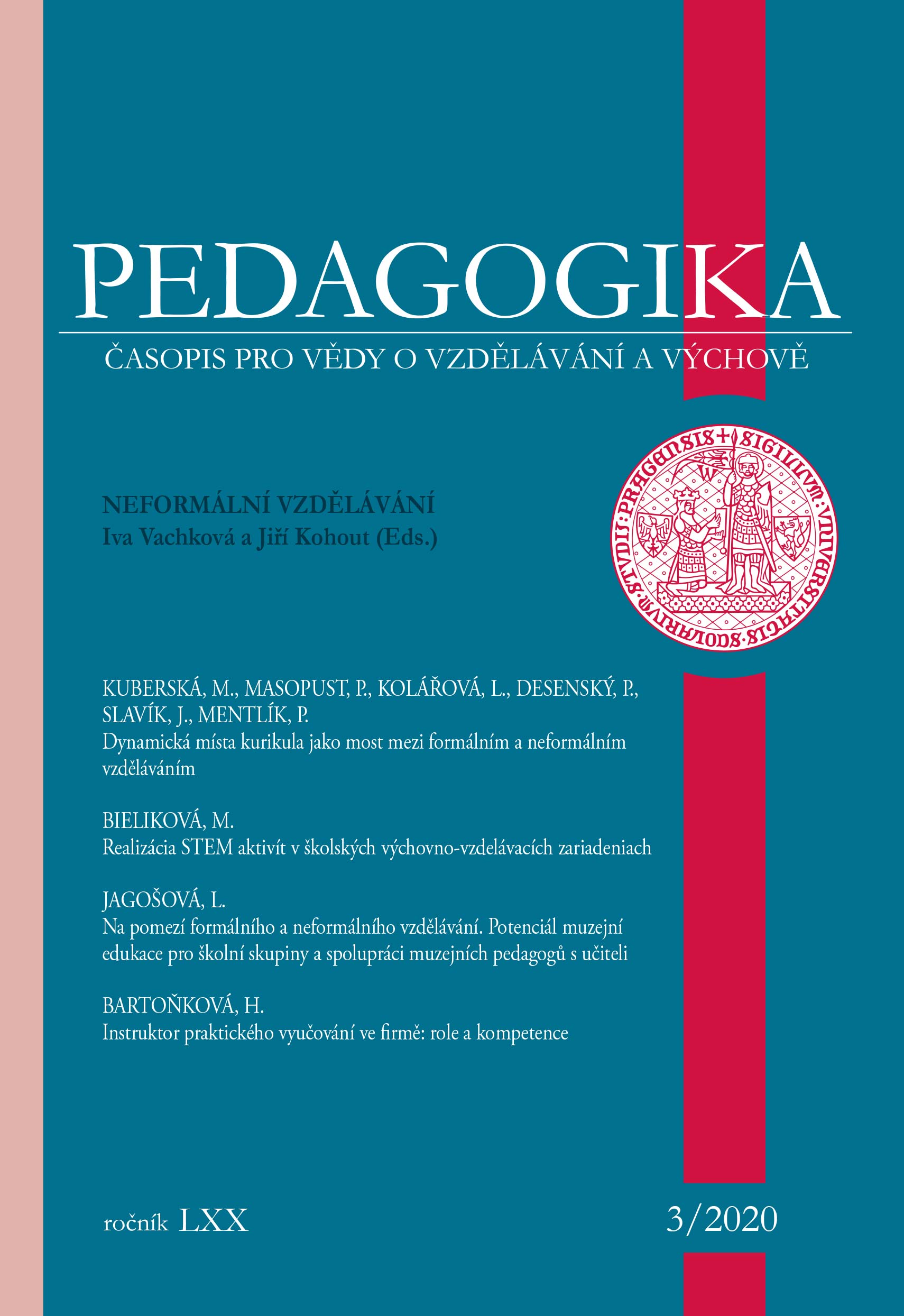Dynamic Areas of Curricula as a Bridge between Formal and Non-Formal Education
DOI:
https://doi.org/10.14712/23362189.2020.1672Keywords:
dynamic areas of disciplines, dynamic areas of curricula, curricular innovation, content transformation, non-formal education, science centresAbstract
The aim of this theoretical-methodological study is to define the construct of dynamic areas of curricula, to contextualize it, to describe the research methods of the construct, and to present examples of good practice. The term ‘dynamic area’ is defined and put into the context of established constructs such as content transformation or the modernization of curricula in the first part of the paper. The role of formal and non-formal education in the process of transformation is discussed in the same part of the paper. The second part deals with research methods for the specification of dynamic areas of disciplines and methods dealing with the selection and legitimization of the dynamic areas for content transformation. The last part focuses on the presentation of examples of good practice. Two suggestions as to how to present selected dynamic areas of geography and physics curricula are described here. The dynamic areas of the curricula are presented as a potential connection between formal and non-formal education in this study. The first reason for this is because of the advantages of cooperation between providers of formal (lecturers and teachers) and non-formal (for example, science centre staff ) education in the process of the specification and selection of the dynamic areas of the disciplines. The second reason is the significant potential of non-formal education institutions for the presentation of selected dynamic areas because of their well-equipped expositions and laboratories. It should be possible to innovate the curricula of formal education through educational programmes offered by non-formal education institutions to schools.
References
Bencze, L., & Hodson, D. 1999. Changing practice by changing practice: Toward more authentic science and science curriculum development. Journal of Research in Science Teaching, 36, 521-539.
https://doi.org/10.1002/(SICI)1098-2736(199905)36:5<521::AID-TEA2>3.0.CO;2-6
Cloutier, R., Dwyer, J., & Sherrod, S. 2016. Exploration of hands-on/minds-on learning in an active STEM outreach program. ASEE 123rd Annual Conference & Exposition. New Orleans, LA (Paper ID #16121).
Durrani, M., & Rodgers, P. 1999. Physics: past, present, future. Physics World, 12, 7-14.
https://doi.org/10.1088/2058-7058/12/12/2
Glänzel, W. 2003. Bibliometrics as a research field: A course on theory and application of bibliometric indicators. Course Handouts.
Gurnell, A. 2018. Twenty-five years of progress in physical geography: A personal view of its antecedents and trajectory. Geography, 103(3), 122-136.
https://doi.org/10.1080/00167487.2018.12094049
Hajerová Műllerová, L., & Slavík, J. 2020. Modelování kurikula. Plzeň: Západočeská univerzita.
Hawley, D., & Lyon, J. 2017. Plate update: Refreshing ideas for teaching plate tectonics. Teaching Geography, 42(1), 30-32.
Janík, T., Maňák, J., & Knecht, P. 2009. Cíle a obsahy školního vzdělávání a metodologie jejich utváření. Brno: Paido.
Janík, T., Slavík, J., Mužík, V., Trna, J., Janko, T., Lokajíčková, V., … Zlatníček, P. 2013. Kvalita (ve) vzdělávání: obsahově zaměřený přístup ke zkoumání a zlepšování výuky. Brno: Masarykova univerzita.
Janík, T. 2018. Od obsahu vzdělávání k žákově znalosti: kritická místa na cestě do školy a ze školy. Arnica, 8(1), 1-8.
Jelemenská, P., Sander, E., & Kattmann, U. 2003. Model didaktickej rekonštrukcie: Impulz pre výzkum v oborových didaktikách. Pedagogika, 53(2), 190-201
Kattmann, U. 2009. Didaktická rekonstrukce: učitelské vzdělávání a reflexe výuky. In: T. Janík a kol. Možnosti rozvíjení didaktických znalostí obsahu u budoucích učitelů (s. 17-32). Brno: Paido.
Klafki, W. 1995. Zum Problem der Inhalte des Lehrens und Lernens in der Schule aus der Sicht kritisch-konstruktiver Didaktik. In S. Hopmann & K. Riquarts (Eds), Didaktik und/oder Curriculum. Grundprobleme einer international vergleichenden Didaktik (s. 91-102). Weinheim u.a.: Beltz.
Knecht, P. 2007. Didaktická transformace aneb od "didaktického zjednodušení" k "didaktické rekonstrukci. Orbis Scholae, 2(1), 67-81.
https://doi.org/10.14712/23363177.2018.152
Knecht, P. 2017. Model didaktické rekonstrukce. In J. Slavík a kol. Transdisciplinární didaktika: o učitelském sdílení znalostí a zvyšování kvality výuky napříč obory (s. 268-275). Brno: Masarykova univerzita.
Kohout, J., Masopust, P., Mollerová, M. et al. 2019a. Kritická místa kurikula fyziky na 2. stupni základní školy I. Plzeň: Západočeská univerzita.
Kohout, J., Mollerová, M., Masopust, P., Feřt, L., & Slavík, J. 2019b. Kritická místa kurikula na základní škole pohledem mezinárodního šetření TIMSS a českých učitelů - poznatky z fyziky. Pedagogická orientace, 29(1), 5-42.
https://doi.org/10.5817/PedOr2019-1-5
Kohoutek, R., & Řehulka E. 2011. Stresory učitelů základních a středních škol v České republice (zejména stresory způsobené žáky). In E. Řehulka (Ed.), Škola a zdraví pro 21. století (s. 105-117). Brno: Masarykova univerzita.
Kolářová L., & Rálišová E. 2017 The concepts of nanotechnology as a part of physics education in high school and in interactive science museum. (Online). AIP Conference Proceedings 1804, 040005
https://doi.org/10.1063/1.4974384
Krninský, L. 2012. Pracovní zátěž a stres v povolání učitele (přehledová studie). e-Pedagogium, 12(1), 82-108.
https://doi.org/10.5507/epd.2012.007
Maňák, J., Janík, T., & Švec, V. 2008. Kurikulum v současné škole. Brno: Paido.
Mentlík, P. 2016. Srovnání dynamiky vědeckých výstupů mezi geografickými obory v ČR (2012 až 2014) pro potřeby cílené didaktické transformace. Arnica, 5(1-2), 1-11.
Mentlík, P., Slavík, J., & Coufalová, J. 2018. Kritická místa kurikula, organizační a klíčové koncepty - konceptuální vymezení a příklady z výuky geověd, Arnica, 8(1), 9-18.
MŠMT. 2017. Rámcový vzdělávací program pro základní vzdělávání. Dostupné z: www.nuv.cz
Pluháčková, M. 2018. Deglaciace v Západních Tatrách a její vazba na gravitační deformace různých typů s didaktickou transformací sledovaných jevů a zjištěných výsledků. Disertační práce. Přírodovědecká fakulta, Ostravská univerzita.
Pluháčková, M., Duffek, V., Stacke, V., & Mentlík, P. 2019. Kritická místa kurikula zeměpisu na 2. stupni základní školy I. Plzeň: Západočeská univerzita.
Rendl, M., & Vondrová, N. 2014. Kritická místa v matematice u českých žáků na základě výsledků šetření TIMSS 2007. Pedagogická orientace, 24(1), 22-57.
https://doi.org/10.5817/PedOr2014-1-22
Slavík, J., Janík, T., Najvar, P., & Knecht, P. 2017. Transdisciplinární didaktika. Brno: Masarykova univerzita.
Vamvakeros, X., Pavlatou, E. A., & Spyrellis, N. 2010. Survey exploring views of scientists on current trends in chemistry education. Science & Education, 19(2), 119-145.
https://doi.org/10.1007/s11191-009-9196-4
Van Noorden, R., Maher, B., & Nuzzo, R. 2014. The top 100 papers: nature explores the most-cited research of all time. Nature, 514(7524), 550-553.
https://doi.org/10.1038/514550a
PMid:25355343
VÚP. 2007. Rámcový vzdělávací program pro gymnázia. Dostupné z: www.nuv.cz



